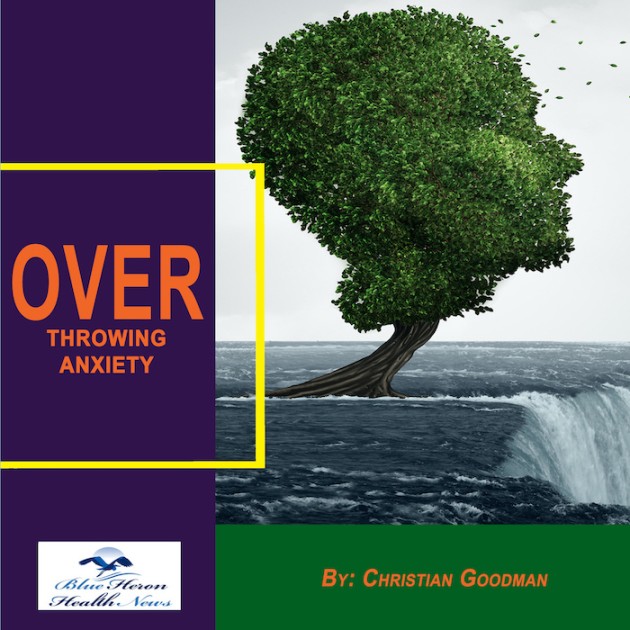
Overthrowing Anxiety™ This eBook includes a complete program to treat anxiety effectively. It guides you to learn the ways to find, understand, and accept the main cause of your anxiety and start using the techniques provided in it to treat the problem.
What is neurogenic orthostatic hypotension?
Neurogenic orthostatic hypotension (NOH) is a specific form of orthostatic hypotension (OH), a syndrome characterized by an acute fall in blood pressure upon standing from sitting or recumbent position. Symptoms of which are dizziness, lightheadedness, and fainting. It differs from others in that it is a consequence of an existing neurological disorder that inhibits the body from effectively regulating the blood pressure.
Causes of Neurogenic Orthostatic Hypotension
Neurogenic orthostatic hypotension is caused by a problem with the nervous system, or more precisely, with the autonomic nervous system (ANS), which is responsible for involuntary activities like blood pressure, heart rate, and digestion. In NOH, the autonomic nervous system is not able to constrict arteries in a manner that would normally cause blood pressure to rise when one stands.
Frequent causes of neurogenic orthostatic hypotension are:
Parkinson’s Disease: A neurodegenerative disorder that also affects movement and can harm the autonomic nervous system, leading to orthostatic hypotension.
Multiple System Atrophy (MSA): A disorder of uncommon neurological disorder with gradual loss of autonomic function and is also responsible for producing severe blood pressure control issues.
Pure Autonomic Failure (PAF): A rare condition where there is progressive autonomic failure of functions like blood pressure control.
Diabetic Neuropathy: Long-standing diabetes can lead to nerve damage, including the autonomic nerves, to result in orthostatic hypotension.
Lewy Body Dementia: A dementia disorder that can affect the autonomic nervous system and lead to difficulties with blood pressure regulation.
Spinal Cord Injury: Spinal cord injury can disrupt the signals necessary for blood vessels to constrict properly on standing.
Other Neurodegenerative Disorders: Other diseases like Alzheimer’s disease or Huntington’s disease can also lead to autonomic dysfunction and NOH.
Symptoms of Neurogenic Orthostatic Hypotension
Symptoms of NOH are similar to those of other types of orthostatic hypotension, but are more likely to be progressive and chronic due to the underlying neurological disorder. These symptoms can include:
Dizziness or lightheadedness upon standing
Fainting or feeling like you are going to faint
Blurred vision
Fatigue
Weakness
Nausea (due to reduced blood flow)
Palpitations or abnormal heart rhythm
They typically occur after a few minutes of standing up and can be exacerbated by the occurrence of such factors as heat, dehydration, or prolonged standing.
How Neurogenic Orthostatic Hypotension Functions
When you stand up normally, gravity pulls blood down to the lower regions of your body. The autonomic nervous system swiftly instructs blood vessels in the legs to close off and the heart to beat faster to push the blood upward towards the brain and other critical organs. In neurogenic orthostatic hypotension, however, nerve impulses that make blood vessels tighter and the heart beat faster are impaired. This causes inadequate blood flow to the brain, which results in the characteristic symptoms of dizziness, lightheadedness, or fainting.
Diagnosis of Neurogenic Orthostatic Hypotension
Physicians typically diagnose neurogenic orthostatic hypotension by:
Measure blood pressure: Tilt table test or active standing test is a common method to measure blood pressure change during standing. A 20 mm Hg or more fall in systolic pressure or a 10 mm Hg or more fall in diastolic pressure upon standing can suggest orthostatic hypotension.
Autonomic function tests: Tests assess whether the autonomic nervous system is operating, e.g., a heart rate response to slow deep breathing, a blood pressure response test during a change in posture.
Neurological exam: A physician may eliminate other explanations and check for reflexes, muscle strength, and coordination.
Imaging and laboratory studies: Tests like MRI or CT scans may be conducted to assess for underlying neurologic disorders such as Parkinson’s disease or multiple system atrophy.
Treatment of Neurogenic Orthostatic Hypotension
Treatment of neurogenic orthostatic hypotension is focused on the control of symptoms and management of the underlying neurologic condition. Some of the common treatments are:
Lifestyle changes:
Increase fluid intake: Fluids can be taken in greater amounts to raise blood volume, improving circulation and blood pressure.
Increased salt intake: In some cases, a rise in salt intake will raise blood pressure, but this should be done under the supervision of a physician.
Compression apparel: Compression socks or abdominal wraps can help to reduce blood pooling in the legs and improve circulation.
Gradual position change: Getting up from sitting or lying down slowly and avoiding sudden changes can help reduce dizziness.
Medications
Fludrocortisone: This medication helps increase blood volume and improve circulation.
Midodrine: A drug that causes blood vessel narrowing, helping to increase blood pressure.
Droxidopa: A medication that increases norepinephrine (a neurotransmitter that helps control blood pressure and heart rate), used for neurogenic orthostatic hypotension due to diseases like Parkinson’s disease.
Physical therapy: Physical therapy to improve muscle tone and balance can be recommended in some cases to reduce symptoms.
Treatment of underlying conditions: Treatment of the underlying conditions, including Parkinson’s disease, diabetes, or multiple system atrophy, may decrease the severity of neurogenic orthostatic hypotension.
Prognosis
The prognosis of neurogenic orthostatic hypotension is influenced by the root cause and control over it. If the illness is associated with a neurodegenerative condition, like Parkinson’s disease, it will presumably be chronic as well as progressive. Nevertheless, with effective therapy and lifestyle changes, most individuals can control signs and have an excellent quality of life.
Conclusion
Neurogenic orthostatic hypotension is a form of low blood pressure that results from autonomic nervous system dysfunction, which compromises the body’s capacity to regulate blood pressure in the upright position. It may result from numerous various neurological disorders, including Parkinson’s disease and multiple system atrophy. Treatment is directed towards managing symptoms and treating the underlying cause, but quality of life and capacity to live with the condition can be enhanced by lifestyle modification, medication, and supportive therapy.
Would you like more information regarding the care of this condition or some therapies for it?
Blood volume contributes to the regulation of blood pressure. Blood pressure is the pressure that the moving blood exerts against the walls of the blood vessels, and it is influenced by many different factors, one of which is the blood in the circulatory system’s volume. Following are the mechanisms through which blood volume affects blood pressure:
1. Direct Relationship Between Blood Volume and Blood Pressure
Increased Blood Volume: When more blood circulates within the body, more blood flows through the arteries and pushes more forcefully on blood vessel walls. This can be a cause of high blood pressure. Increased blood volume can be caused by factors such as fluid overload, kidney disease, or excessive salt intake that causes the body to retain water and sodium.
Reduced Blood Volume: As the blood volume decreases, there is less blood passing through the body, which means less pressure on the blood vessels. This can lead to low blood pressure (hypotension). Blood volume loss may happen because of blood loss (such as trauma or surgery), dehydration, or disorders such as hemorrhagic shock where the body loses a large quantity of fluid.
2. Mechanisms that control Blood Volume and Blood Pressure
Several systems in the body regulate blood volume to maintain appropriate blood pressure:
Kidneys: Kidneys play an important role in regulating blood volume by regulating the amount of sodium and water that is excreted or retained. To add blood volume (and, in turn, blood pressure) when the body needs it, kidneys can retain sodium and water and thereby expand blood volume. To reduce blood volume and blood pressure, kidneys can excrete surplus sodium and water.
Hormones:
Antidiuretic Hormone (ADH): During reduced blood volume, the pituitary gland releases ADH (vasopressin). The hormone tells the kidneys to retain water, hence increasing blood volume and blood pressure.
Aldosterone: This is the hormone released by adrenal glands that is involved in regulating the balance of sodium and water. It provokes the kidneys to retain sodium, hence increasing blood volume and blood pressure indirectly.
Renin-Angiotensin-Aldosterone System (RAAS): Triggers if blood pressure or volume drops. It leads to the release of renin, which eventually causes angiotensin II to be generated. Angiotensin II is a powerful vasoconstrictor that narrows blood vessels and increases blood pressure. It also leads to the release of aldosterone, which further increases blood volume.
Sympathetic Nervous System (SNS): The sympathetic nervous system would increase blood pressure and speed up the heart rate because of low blood pressure, thereby increasing blood pressure. This is done in harmony with the adjustment of blood volume in an effort to maintain level pressure.
3. Blood Volume and the Circulatory System
Arterial Pressure: Arterial pressure (systolic and diastolic blood pressure) is largely controlled by the amount of blood pumped by the heart (cardiac output) and resistance of the blood vessels. Increased blood volume increases cardiac output, and hence can increase arterial pressure.
Venous Return: Venous return is the return of blood to the heart. The amount of blood increases, raising venous return and consequently cardiac output, increasing blood pressure in response. A low volume of blood causes reduced venous return, lowering cardiac output and blood pressure.
Vascular Resistance: Blood volume also influences blood vessel diameter and tone. With increased blood volume, the blood vessels may expand slightly, thereby raising vascular resistance and blood pressure. Very high blood volume can lead to high blood pressure, or hypertension; low blood volume can lead to low blood pressure, or hypotension.
4. Changes in Blood Volume in Health Conditions
Hypertension: In essential hypertension, the body may be in a state of excess fluid retention, leading to elevated blood volume and in turn, high blood pressure. This is typically compounded by such conditions as excess sodium, kidney disease, or endocrine disorders.
Hypovolemia: A significant decrease in blood volume, e.g., because of abundant bleeding or dehydration, can lead to hypovolemic shock, with decreased blood pressure, tachycardia, and insufficient perfusion of organs.
Heart Failure: In heart failure, the heart fails to pump blood in a normal way, leading to too much excess water retention and increased blood volume. Too much volume again can overwhelm the heart and increase high blood pressure, particularly venous pressure, causing symptoms like swelling of the abdomen and legs.
Chronic Kidney Disease: Kidneys also play a fundamental function in regulating blood volume and blood pressure. As kidney function deteriorates, the body may experience excess sodium and water retention and lead to fluid overload and increased blood pressure.
5. Effect of Blood Volume on Regulation of Blood Pressure in Different Postures
Standing: As a person stands, gravity causes blood to be pulled into the lower limbs and temporarily reduce venous return and decrease blood volume being returned to the heart. This may cause a temporary decrease in blood pressure (orthostatic hypotension). To compensate, the body can release hormones and increase heart rate so that blood pressure is preserved.
Lying Down: In the recumbent position, blood is better distributed and venous return is enhanced, perhaps leading to a mild increase in blood pressure. But since the heart is not fighting gravity, the amount of blood being distributed may be normalized, so a normal reading will be obtained when resting.
6. Conclusion
Blood volume directly influences blood pressure, and the body has complex mechanisms to regulate both. A rise in blood volume can lead to elevated blood pressure (hypertension), while decreased blood volume can lead to low blood pressure (hypotension). Normal blood pressure is crucial for proper blood volume regulation, and any abnormality can lead to a variety of health problems.
Overthrowing Anxiety™ This eBook includes a complete program to treat anxiety effectively. It guides you to learn the ways to find, understand, and accept the main cause of your anxiety and start using the techniques provided in it to treat the problem.
